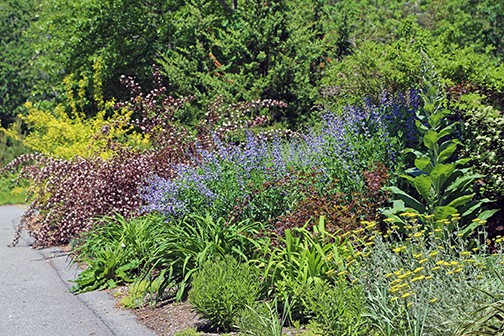A Gardening Life – June 4
If your garden is near the road, chances are it’s hot and dry. Asphalt and concrete absorb heat so the soil near these surfaces is usually drier than gardens located elsewhere. And then there’s the matter of the hose or irrigation reaching that far…
When we moved to Poison Ivy Acres five years ago the area up by the street was a strip of lawn. I immediately knew that I needed to smother the turf and create drought-resistant gardens here. I wanted more color and less mowing.
After carpeting the grass with newspapers and bark mulch I began to place drought-tolerant plants in the strip along the road. It’s an area that is still evolving as I encourage the butterfly weed seedlings and the dry garden’s overachiever, ‘Zagreb’ Coreopsis. ‘Zagreb’, by the way, is the plant world’s answer to the question “Who says that a groundcover needs to be short and evergreen?”
One of the secrets to a satisfying life is not complaining about existing conditions but to work within these limitations to create something good. Or better. The garden is the perfect place to practice such an attitude.

I think that this garden is particularly striking in June. Blue Baptisia shows off with Physocarpus "Summer Wine" in the background and "Coppertina" in the foreground. The Verbascum is setting buds and the butterfly weed, daylilies and Coreopsis are growing, preparing for their July bloom.
Sharing the Wealth
Planting That Hot Strip Along The Road:
- Keep as much organic matter in the soil as possible. We didn’t remove the lawn, we just covered it up so that it added organics to the soil.
- Find the drought-tolerant plants that do well in your area. Look for those that out-compete the weeds by growing thickly. In my dry garden, for example, the ‘Zagreb’ Coreopsis doesn’t let any weeds take hold where it grows. The asters, however, are plants that have enough light and space in between their stems that it’s an invitation for the neighbors (weeds) to share their space.
- If you need to water in the dry garden do so deeply but not very often. A long soaking every three weeks keeps root systems alive down deep in the soil where the moisture lingers.
- Mulch.


